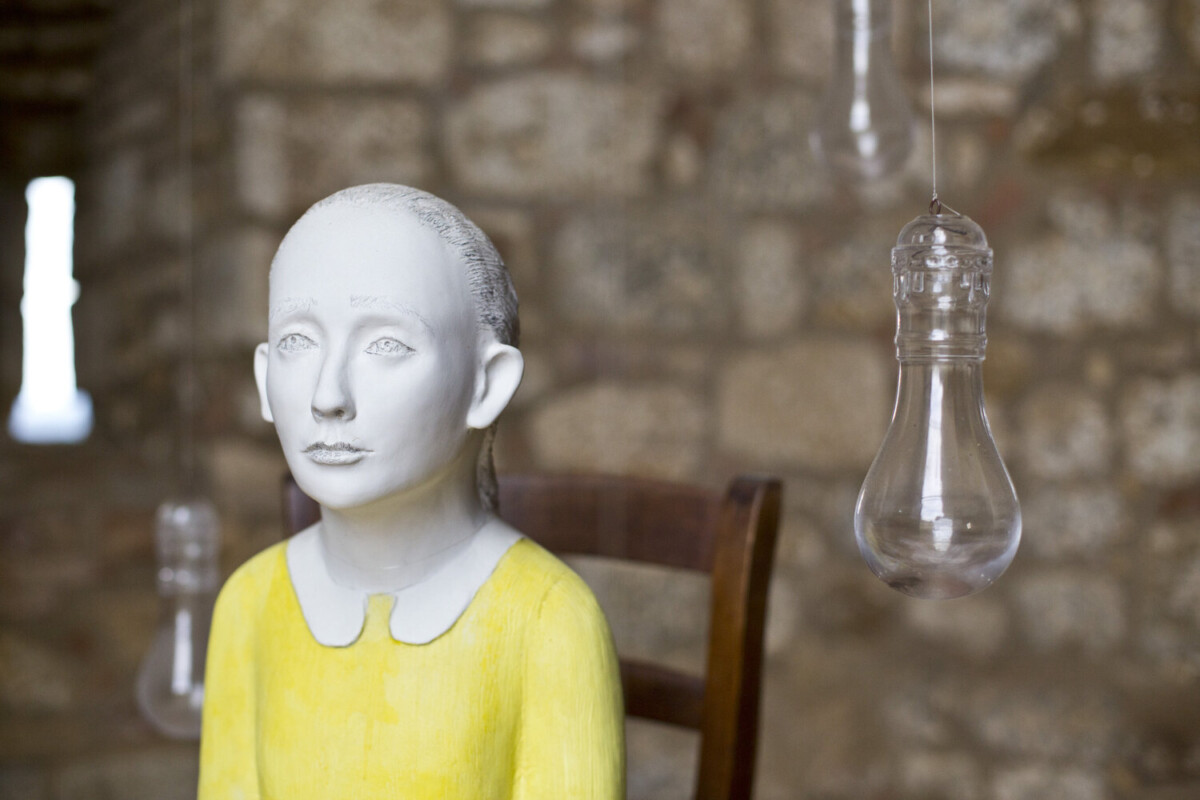Words by Kiki Smith about color still
“Nel 2003, Cai Guo-Qiang mi ha invitato a pensare ad un lavoro per il suo DMoCA (Dragon Museum of Contemporary Art) in Giappone. Ho realizzato per l’occasione Pause un lavoro che era formato da 9 sculture di donne in ceramica sedute all’interno di un tipico forno giapponese che è il museo. La loro ripetizione fa riferimento ai singoli fotogrammi di un film.
Ciascuna giovane donna sedeva sola con un fascio di legna, riposandosi dalla raccolta della legna nel bosco. Recentemente Cai mi ha chiesto di includere un pezzo nella sua mostra del 2008 Everything is Museum che coincideva con una sua retrospettiva itinerante. Per questa mostra ho proposto allora una delle fanciulle, con un vestito colorato di blu. Lei è diventata una delle guardie incaricate di prendersi cura del museo. Quando poi mi ha chiesto di fare un lavoro per l’UMoCA (Under museum of contemporary art) a Colle di Val d’Elsa, ho portato tre delle fanciulle in Italia, in questa nuova occasione, una col vestito rosso, una col vestito blu e una col vestito giallo. Ognuna di loro è stata posizionata seduta sotto uno degli archi nei quali si sviluppano gli spazi del museo.
Gi archi del ponte, ognuno unico ma ripetitivo come fermi immagine di un film, mi hanno dato da subito la possibilità di riferirmi a Pause. La gente di Colle di Val d’Elsa e Mario Cristiani di Associazione Arte Continua mi hanno dato l’opportunità di lavorare in collaborazione con il conosciuto consorzio del cristallo di Colle. Loro hanno prodotto per l’occasione una moltitudine di lampadine ingrandite in cristallo soffiato. Le lampadine rappresentano l’accensione dell’ispirazione, dell’immaginazione e della chiarezza offerte dalla luce, che poi rappresenta il significato delle idee. La luce illumina ciascuna scultura, che celebra la profonda e misteriosa connessione tra le fanciulle e l’universo. C’è una grande importanza del rapporto delle fanciulle con la natura, proprio per il nostro futuro. Senza riflettere coscientemente sull’immenso lavoro di Cai con arcobaleni e colori, ho notato come gli archi del museo mimino la natura dell’arcobaleno e illuminano lo spazio nella notte con un arcobaleno di luci colorate. La notte le lampadine catturano i colori e animano gli archi creando un “arcobaleno notturno”. Allora siamo in un luogo mistico e mitologico, ricordo dei primi esperimenti della proiezione di film. Sono entusiasta di avere questa opportunità di creare un lavoro sotto la strada che conduce al monastero dedicato a san Francesco, proprio perché lui rappresenta l’interconnessione spirituale degli esseri umani nel mondo naturale. In riferimento a San Francesco, le lampadine illuminano sia le condizioni passate che quelle presenti e riportano sotto attenzione le connessioni tra le funzioni del ponte pubblico, del parco per i bambini, per la comunità e per l’ambiente naturale di colle di val d’elsa e del mondo tutto.”
Words by Cai about color still
“Color Still è la terza mostra personale all’UMoCA. Il primo evento ha portato a Colle i lavori di Ni Tsai-Chin, curatore e artista di Taiwan, seguito dalla presentazione di Jennifer Wen Ma, cinese di origine, ormai stabilmente negli Stati Uniti. Mi emoziona che sia Kiki Smith la terza presenza all’UMoCA. Nella mostra di Kiki l’elemento centrale è una fanciulla. Essa appare per la prima volta nel mio progetto curatoriale nel 2003, intitolato Pause, dove un gruppo di fanciulle identiche erano riunite intorno al fuoco in un bosco, schierate come un coro, quasi in un sentiero verso il paradiso, in cerca di un luogo di pace e salvezza dove fermarsi. Più tardi, con la mia serie Everything is Museum nella retrospettiva a metà della mia carriera artistica, le fanciulle hanno viaggiato dal Solomon R. Guggenheim Museum di New York, al National Museum of Art a Beijing al Guggenheim Museum di Bilbao. La fanciulla, sempre seduta all’ingresso della mostra, sembrava proprio una guardiana del museo. Era difficile distinguere se lei fosse un’opera d’arte oppure un visitatore che guardava un’opera d’arte. Ora la fanciulla compie il suo viaggio sotto gli archi dell’antico ponte di pietra della pittoresca Colle di Val d’Elsa, guardando oltre la cittadina toscana centenaria, con uno sguardo rivolto alla confusione dell’autostrada. Forse la sua mente vaga altrove, oppure in nessun luogo – è in pausa. La mia serie dei MoCA comprende, DMoCA (Dragon Museum of Contemporary Art) che è stato creato da un forno, originariamente utilizzato per la cottura della porcellana (Dragon Kiln), nella città dove abito, Quanzhou. Il forno, ricostruito mattone per mattone sulla Tsunan Mountain, è divenuto un punto di aggregazione per eventi culturali. Alcuni bunker trasformati a Kinmen Island, ora sono divenuti il BMoCA (Bunker Museum of Contemporary Art) che accoglie infiniti visitatori dalla Cina, dove di solito erano puntati i cannoni. Colle di Val d’Elsa è uno dei principali centri di produzione del cristallo al mondo. Integrando l’abilità artigiana con il tocco di un’artista internazionale, Kiki Smith, spero che Color Still possa interpretare una nuova idea e nuove possibilità artistiche. Un artista, come me, direttore e curatore dell’UMoCA, vorrebbe farne non solo un museo, ma anche un vero ponte, che metta a confronto con Colle di Val d’Elsa culture da tutto il mondo”

